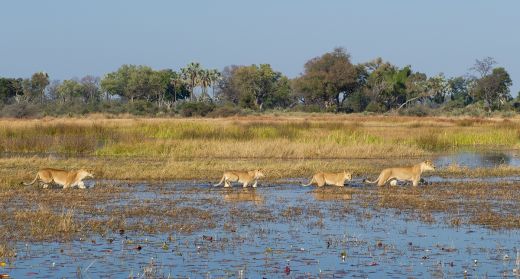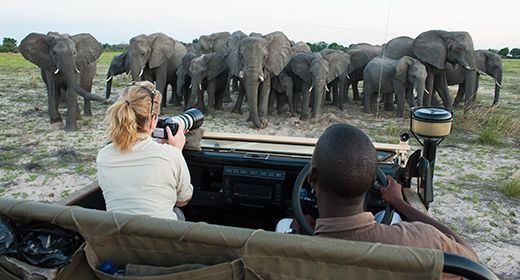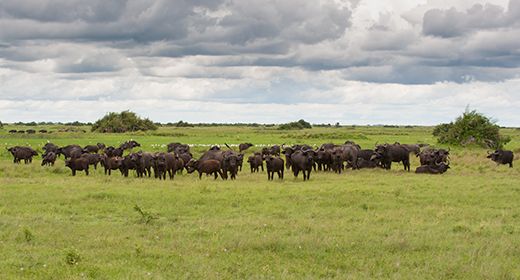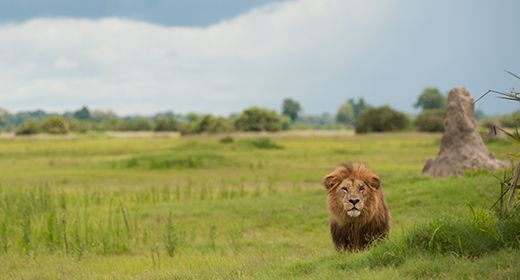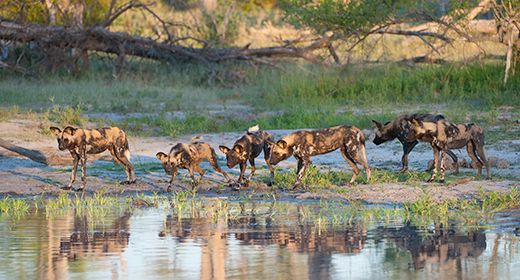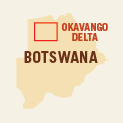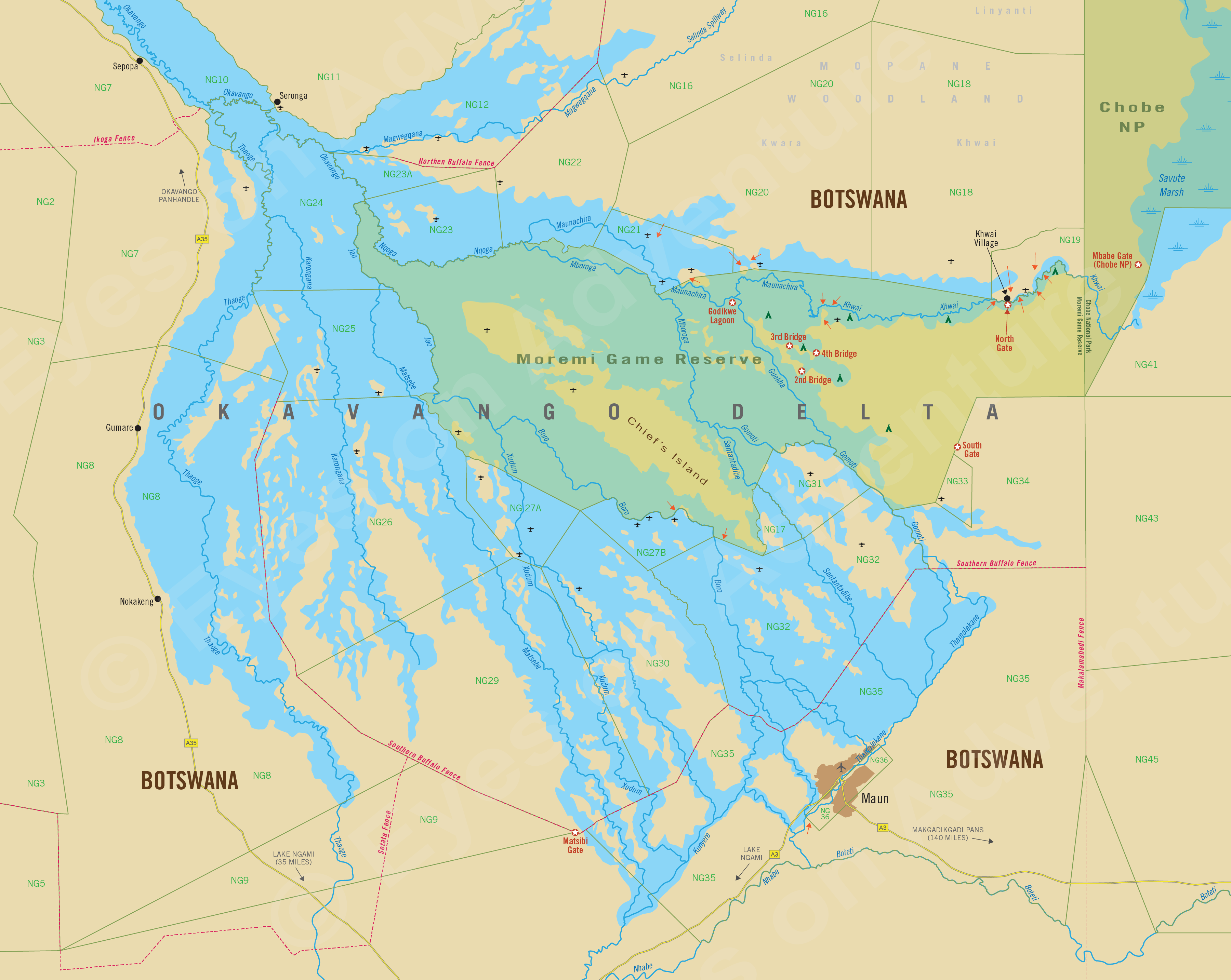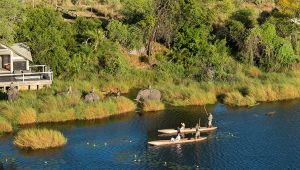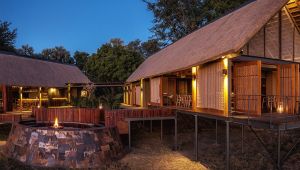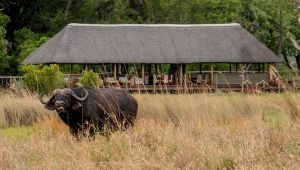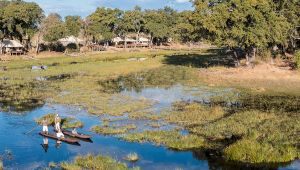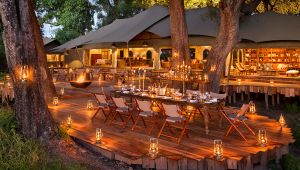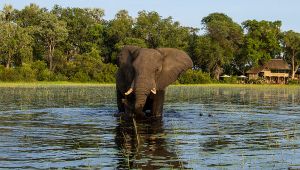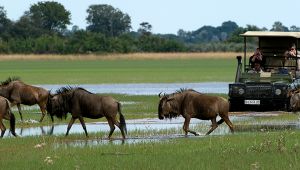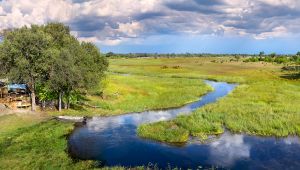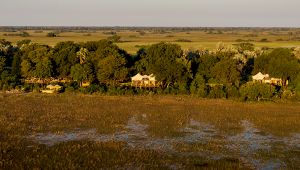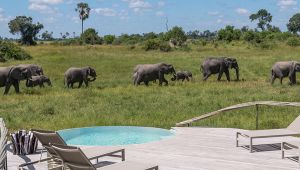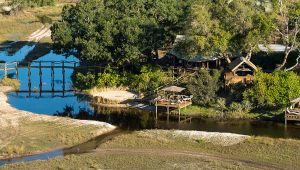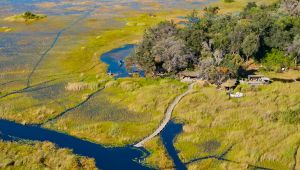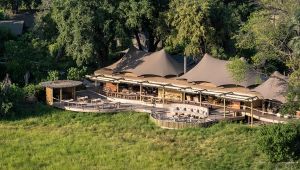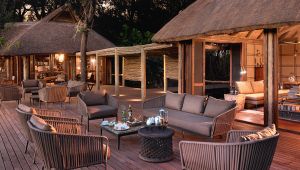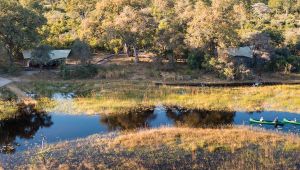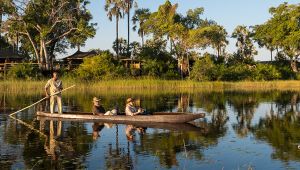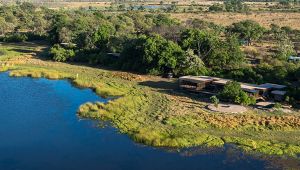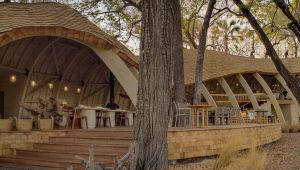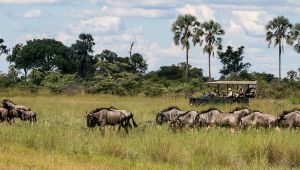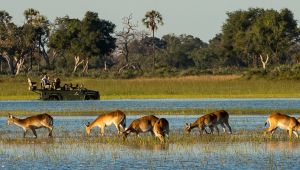Okavango Delta
(incl. Moremi Game Reserve)
Region Links: Central Kalahari, Linyanti & Chobe, Makgadikgadi, Okavango Delta, Okavango Panhandle, Tuli Block
Highlights
- Abundant wildlife, stunning scenery and world-class safaris in a dynamic wetland paradise.
- Palm trees, rivers, seasonal floods and The Big 5 in the Kalahari Desert!
- Travel through pristine channels and lagoons on a traditional mokoro.
- Enjoy exclusivity in remote camps with all the comforts.
EOA Recommends: Chitabe Camp, Duba Explorers Camp, Machaba Camp, Mombo Camp, Sanctuary Chief's Camp
The Okavango Delta is one of Africa's most beautiful and wildlife-rich ecosystems. It is a wilderness paradise of clean, fresh water flowing through papyrus-lined channels, islands of palm trees, and plentiful wildlife. A true mystery, all of this occurs in the Kalahari Desert!
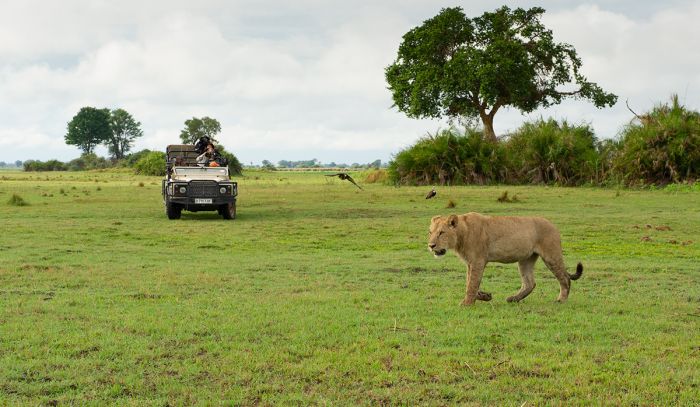
Lion in the Okavango Delta (Copyright © James Weis).
The Okavango Delta is fed by rains falling far to the north in the Angola highlands. This water takes months to travel south via rivers before emptying into this wetland paradise, where wildlife roams free as it has for centuries. Game viewing in the Delta is excellent throughout the year and it is considered to be the crown jewel of safari destinations.
The Moremi Game Reserve is the heart of the Okavango and wildlife here is fully protected. Bordering Moremi on all sides are private reserves (known as concessions) that are leased by Botswana's government to safari companies and local communities under strict guidelines as to its use and maximum tourist beds.
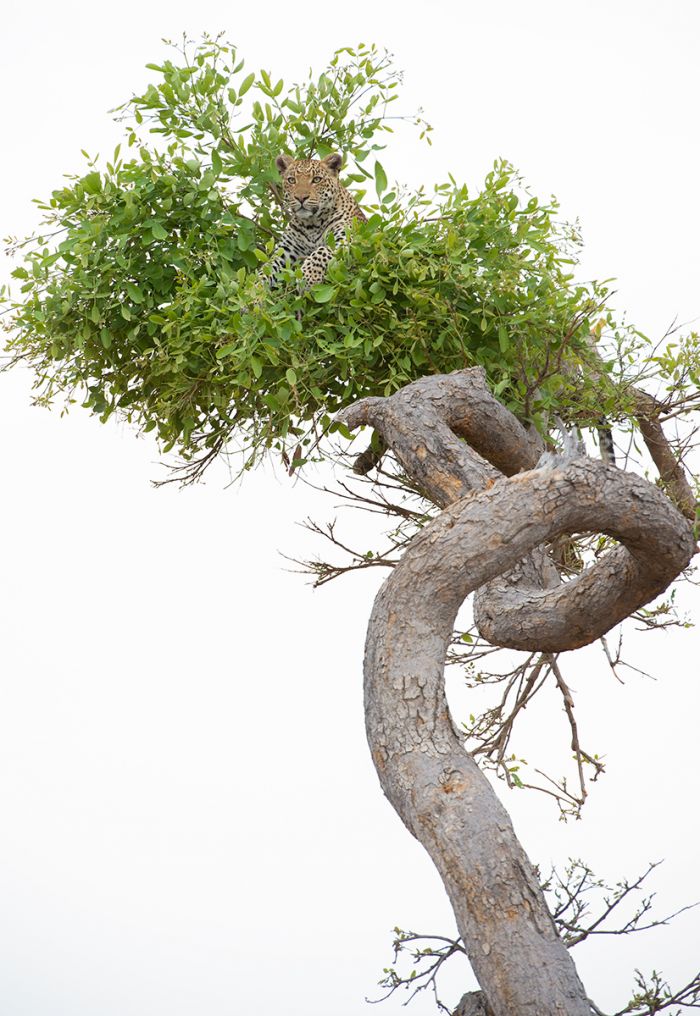
Leopard lookout in one of the Okavango's private concessions (Copyright © James Weis).
The private concessions surrounding Moremi Game Reserve offer wildlife safaris of the highest quality. Low tourist numbers and huge tracts of pristine wilderness evoke a feeling of exclusivity nearly impossible to find anywhere else in the world. Safaris here are like discovering Africa as it existed before settlers arrived.
The Okavango has water throughout the year, even during the dry months, and water is a main component of safaris here. Game drives, boat safaris and rides in a 'mokoro' (a local canoe) are all activities offered in the Delta.
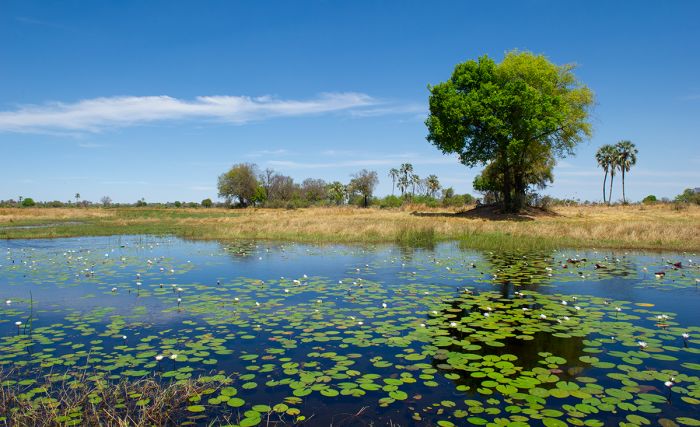
Water lilies growing in Okavango flood water (Copyright © James Weis).
The Okavango is home to all of the Big Five animals (lion, leopard, elephant, rhino, and buffalo), rare species like the African wild dog and sitatunga, plentiful plains game, and over 400 species of birds, including 'Okavango specials' and plenty of migrants during the summer months. All of this in some of Africa's finest safari camps!
The Okavango Delta was declared an UNESCO World Heritage Site in 2014.
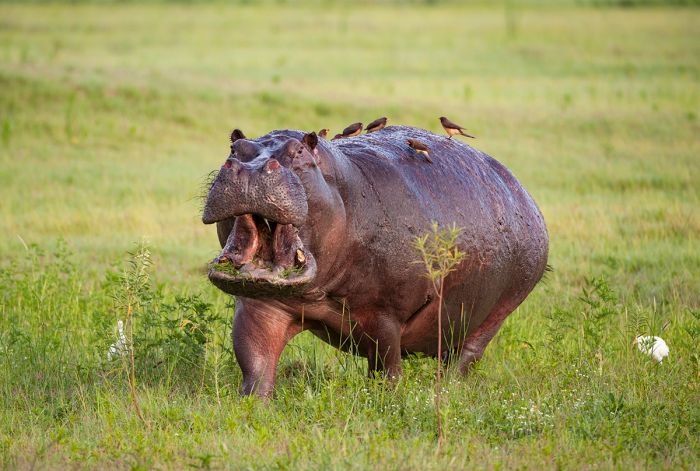
A hippo heading overland with passengers (Copyright © James Weis).
Read More...
Geography, History, Maun, Moremi Game Reserve, Okavango Dynamics, Private Concessions, Rhinos, Wildlife & Safaris
History
The Okavango Delta is located at the far southern end of Africa's Great Rift, which begins far north at the Red Sea is slowly splitting apart the continent. The Rift passes through Ethiopia, Kenya, Uganda, and Tanzania. From Tanzania it splits and cuts through Malawi and Mozambique in the east and through Zambia's Luangwa Valley and Zimbabwe's Kariba Valley, eventually reaching the Victoria Falls. From there it cuts into Botswana, where it is at its smallest.
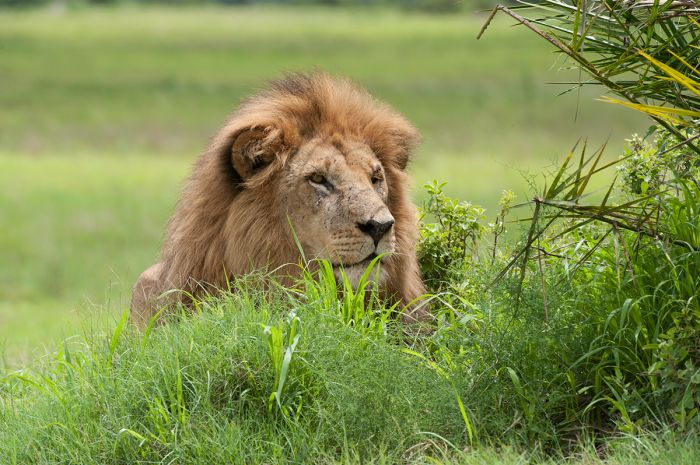
A male lion in the Okavango Delta (Copyright © James Weis).
The main Okavango rift lies between two parallel fault lines - one at the lower extremity of the Delta passing through Maun (the Thamalakane fault) and the other at the northern edge of the Delta along the line of the Selinda Spillway (the Gomare fault).
The area of land between the two southwesterly faults has dropped about 1 000 feet (300 m), forming the Okavango trough, which contains the Delta's water. Over time, the trough filled with windblown sand from the Kalahari desert and sediments carried by the Okavango River, creating a rich and productive biological substrate for vegetation and wildlife support.
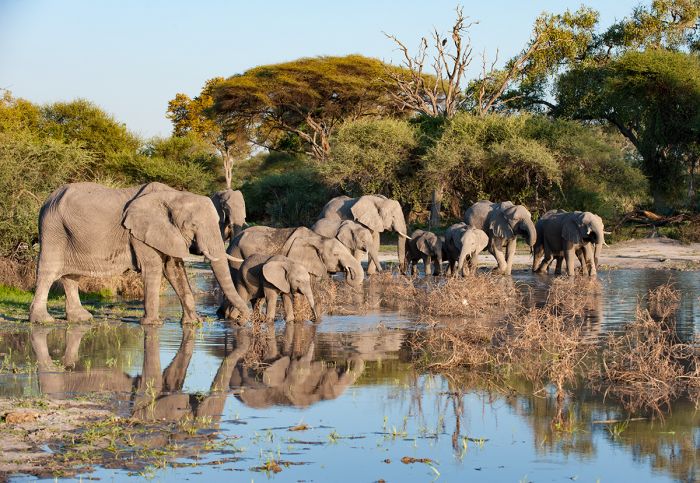
Elephants drinking from the Delta's water (Copyright © James Weis).
Before the Okavango rift formed, the Okavango River flowed directly through the area into the Makgadikgadi Pans and out to the Indian Ocean via the Limpopo River. When the Thamalakane fault at the lower edge of today's Delta rose up, the Okavango River's flow was blocked and this began the Delta's formation.
Humans are thought to have inhabited the Okavango region for at least 100 000 years. The first people living in the Delta must have enjoyed its great bounty, with plenty of mammals, fresh water, fish, and vegetation combining to make it a place of plenty.
The early humans of the Okavango were the hunter-gatherer ancestors of the present-day San Bushman people. Bantu-speaking people arrived from the north, bringing with them agriculture and their descendants now form the majority of the Delta's inhabitants, including the Bugakhwe, Wayeyi, and Hambukushu.
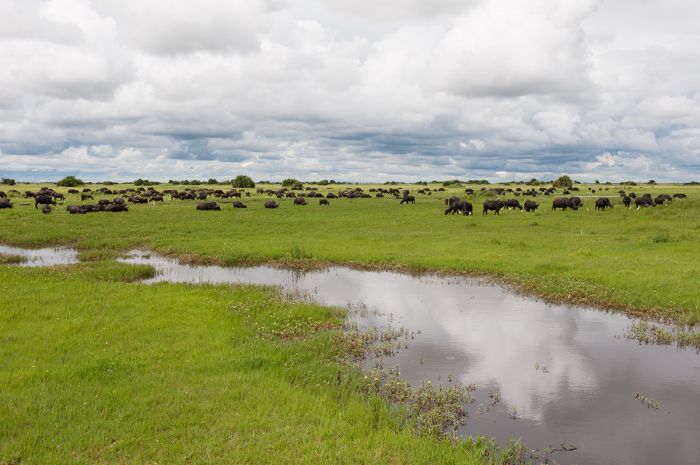
Buffalos enjoying fresh grass in the Okavango (Copyright © James Weis).
geography
Dubbed the ‘Jewel of the Kalahari’, the Okavango Delta wetlands are an exquisite example of the bounty of Africa. Although technically an 'alluvial fan' and not a true delta (as its water never reaches the sea), the shape appears like a delta when viewed from far above.
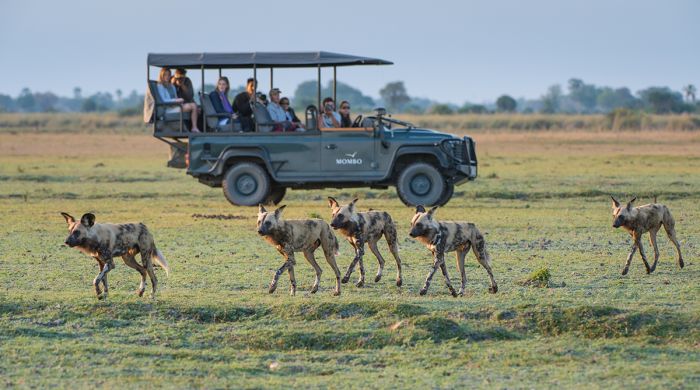
African wild dogs hunting in the Okavango Delta (Copyright © James Weis).
The Okavango is created by waters flowing down the Cubango/Okavango River from the catchment in the Angolan highlands to the north and spilling into a tectonic trough between two geological fault lines in a portion of the Kalahari Desert. It is without doubt one of the world’s most spectacular, beautiful and dynamic natural places.
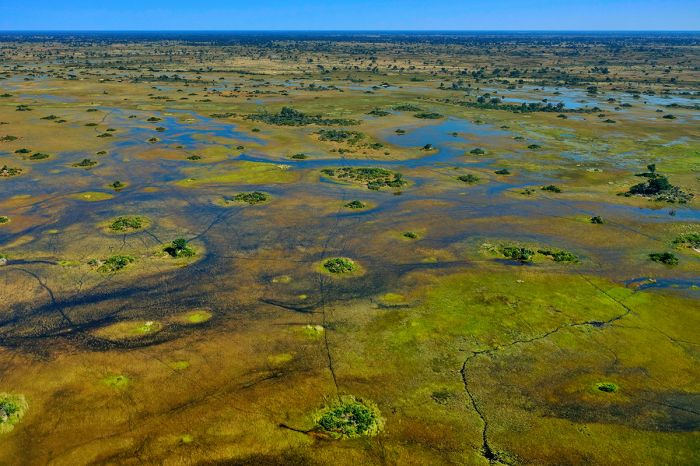
Aerial view over the Okavango, showing the flood water.
The Okavango Delta is a highly dynamic ecosystem as annual flood waters reaching it can fluctuate widely based on the rainfall in Angola. The myriad channels that fill and flow in a given year may become blocked by building sediment or vegetation and cause new channels to form, thus changing year to year.
Another factor adding to the dynamics of the Delta is the shifting tectonics well below the sands. These subterranean movements cause slight elevational changes on the surface and alter channel routes.
Based upon the size of a flood in any given year, the extent of the Okavango Delta ranges between 5 800 - 8 500 square miles (15 000 - 22 000 sq kms).
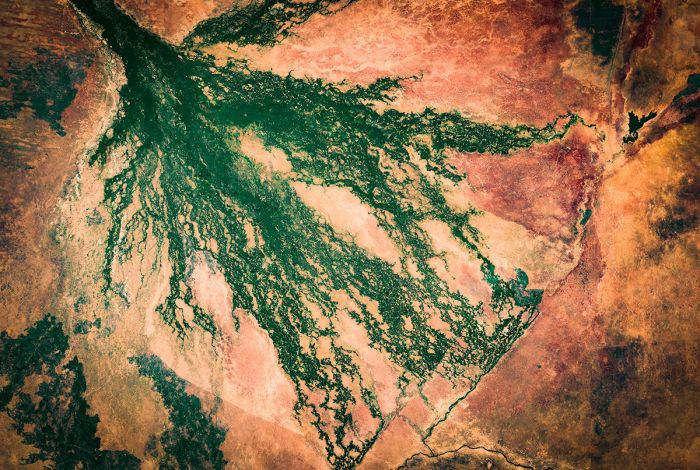
Satellite image of the Okavango Delta.
Okavango Dynamics
The Okavango receives water from two different sources, at two different time per year. The first is the annual flood, arriving from rains falling during January far to the north in Angola and arriving via rivers flowing south to Botswana a couple of months later. The second is local rains, which fall on northern Bostwana between November and April.
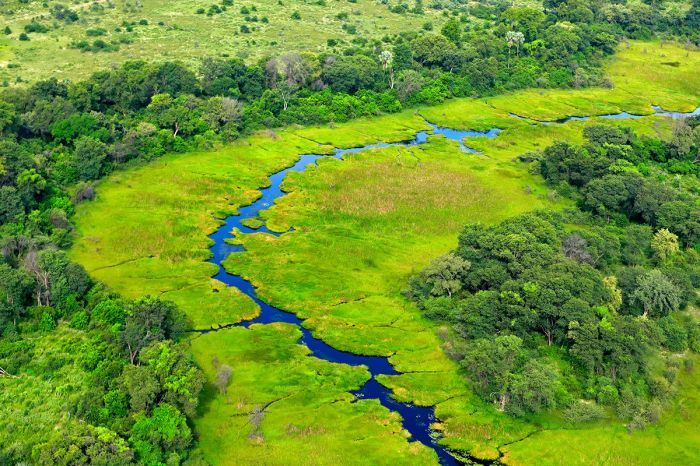
Typical Okavango Delta channel in the green season.
The summer brings the rain and this is often referred to as the 'green season'. The winter months bring the flood water and, although the Delta becomes full of water in the winter, the grass and land around the channels is mostly brown and dry.
Due to the lack of water other than in the larger channels, these winter months are the busiest for tourism, as animals like elephants are more likely to be found around these more permanent water sources.
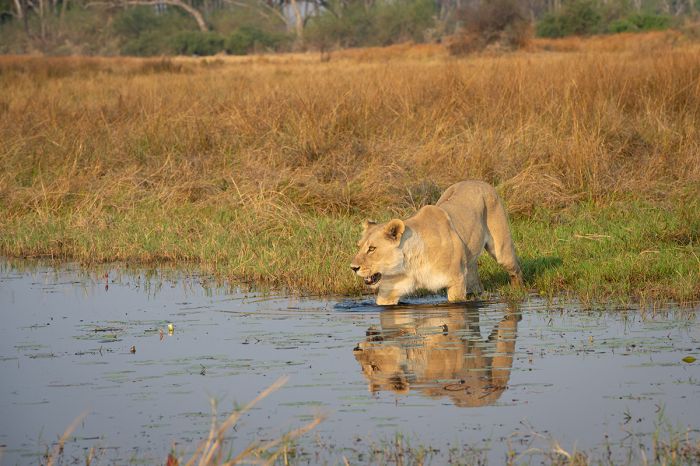
Lioness about to cross flood water in late September (Copyright © James Weis).
The largest volume of flood water flows into the Okavango from March through May, having taken several months to flow south from Angola to finally reach the far northern Delta (the 'Okavango Panhandle'). This flood water may take an additional 2-3 months to travel from the northern Panhandle, through the myriad rivers and channels of the Okavango, and down to Maun in the south of the Delta.
Although the distance from the northern Panhandle to Maun is only 160 miles (260 kms), the north-to-south gradient of the Okavango trough is very slight and its passage is further slowed by papyrus and other swamp vegetation, so the water takes a long time to travel this distance.
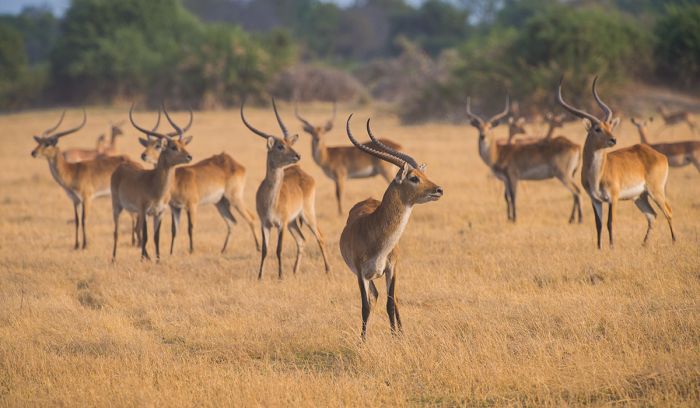
Red lechwe antelopes photographed in September (Copyright © James Weis).
Evaporation and transpiration eliminates much of the flood water in the Delta by sometime in October. Water levels are reduced significantly in the big rivers and perhaps completely in the smaller channels and pans. By late October the land becomes very dry, with only the permanent channels of the Delta still holding water.
Rains in the Okavango occur in the summer months, with sporadic showers typically starting sometime in November and reaching their peak in January and February. By the end of April the rainfall has abated.
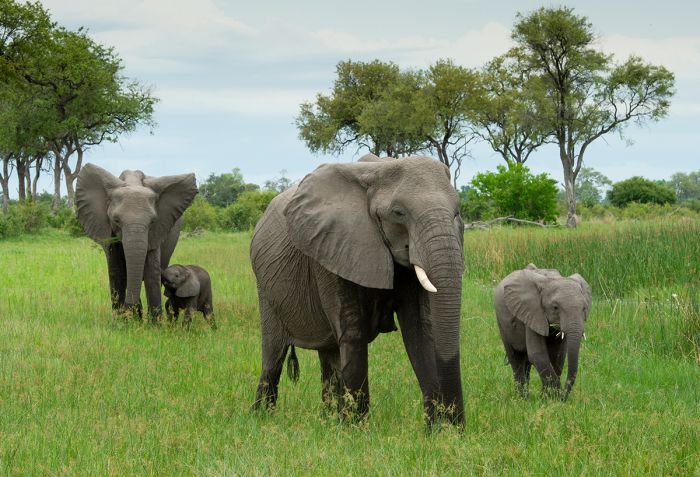
Lush green vegetation in December after the rains have started (Copyright © James Weis).
After the rains have begun, the land in the Delta is transformed into a verdant paradise of greens and blues, with flowers on the ground and in the trees. Many herbivores that depend on fresh grazing (like impalas and warthogs) give birth during this 'green' season.
The fresh water fills pans across the region and fresh grass covers the plains, nourishing an abundance of new life in the Delta, including many thousands of birds from far north, which migrate here to nest and stay through the summer.
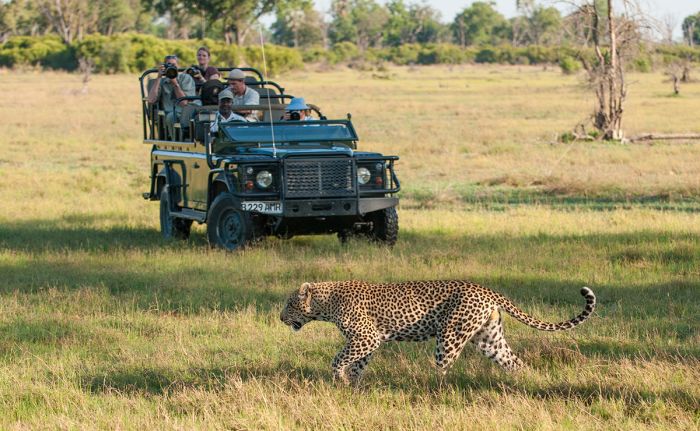
A leopard seen up close (Copyright © James Weis).
Moremi Game Reserve
Situated on the eastern side of the Okavango Delta, the Moremi Game Reserve is a fully protected area, much like a National Park. The only difference is that local BaSarwa people living here were allowed to remain living within the reserve.
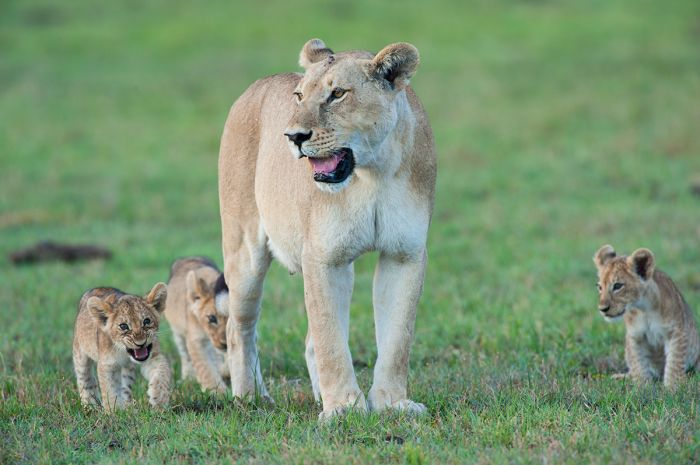
Lioness and cubs in the Moremi Game Reserve (Copyright © James Weis).
Covering roughly 1 900 square miles (5 000 sq kms ) of the central and eastern part of the Delta, Moremi contains all the major habitat types found in the Okavango, including permanent water, mopane woodland, acacia forest, savanna grasslands, floodplains, lagoons, and palm islands. Only 30% of the reserve is land, with the majority being permanent or seasonal water.
The reserve was declared in 1963 and named for the Batawana Chief, Moremi III. The chief's widow, who was ruling at this time, proclaimed the reserve out of her concern that hunting was extracting too great a toll on the region's wildlife. Later during the 1970s, the reserve was extended to include Chief's Island, then known as Chief Moremi's Royal Hunting Grounds.
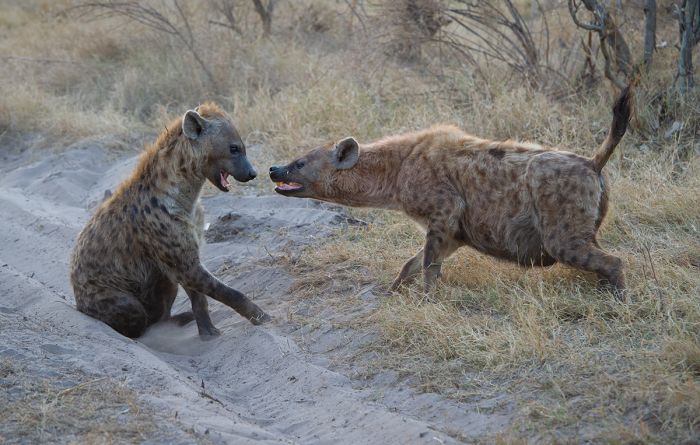
Spotted hyenas in the Moremi Game Reserve (Copyright © James Weis).
Roughly 1,000 square kms (400 sq miles) in size, the Chief's Island is the largest expanse of solid ground within the Okavango Delta and it is thought to have been formed by tectonic uplifting.
Today there are only a handful of safari lodges and some non-permanent camping sites located within the reserve itself, and hunting of any kind is strictly prohibited. Game viewing in Moremi is spectacularly good.
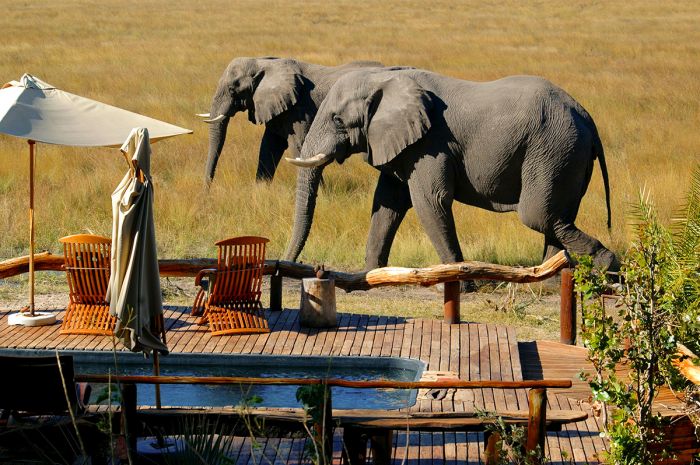
Elephants stroll past a safari camp in the Okavango Delta.
Private Concessions
The entire land area of Botswana is now divided into tracts of land called Wildlife Management Areas (commonly referred to as 'concessions'). The concessions are organized, wherever possible, around existing settlements and those under community management are designed to benefit the local people and give responsibility for managing and administering wildlife to the local community.
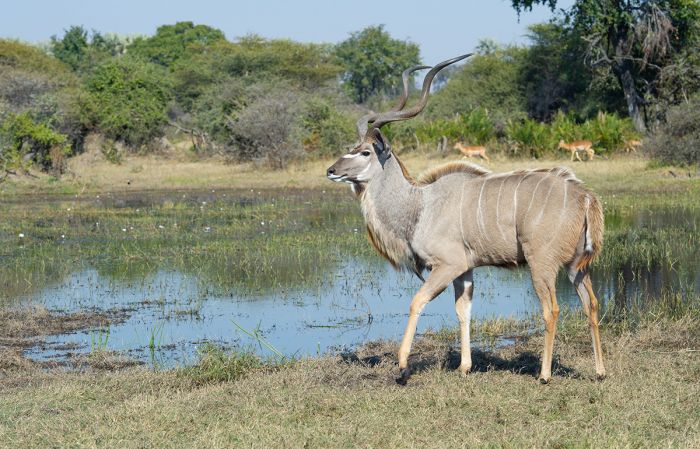
Greater kudu with flood water in the Delta (Copyright © James Weis).
In the past two decades, photo safari operators have negotiated sub-lease agreements for the use of many of the community-managed concessions. This was mostly due to the high demand for this type of tourism and the limited number of beds available is safari areas.
Many new safari camps were built in the Okavango during this time and the number of concessions allowing commercial hunting dropped to zero. In fact, twenty years ago, the majority of the Okavango (outside of Moremi Game Reserve) was hunting area, but photographic tourism has won out over consumptive use of wildlife.
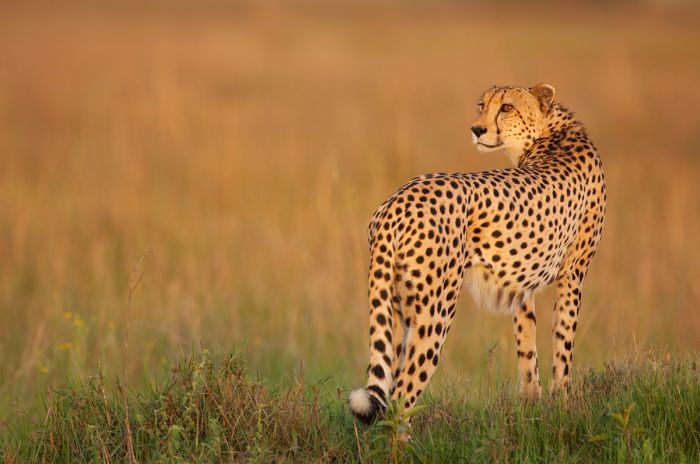
Cheetah in the Okavango Delta (Copyright © James Weis).
Concession lease periods usually run 15 years or so and the land remains in the ownership of the country; the private sector may not own the land. Significant revenue is paid to local sources before profits may be realized by the private sector and the number of beds allowed is strictly enforced.
Concession operators pay high annual fees for each vehicle, aircraft and boat used within the area and must employ locals from the area as guides and to help operate the camp, thus reinforcing the policy of involving and benefiting the communities living in and around the concessions. See our map above for concession boundaries and safari camps and lodges.
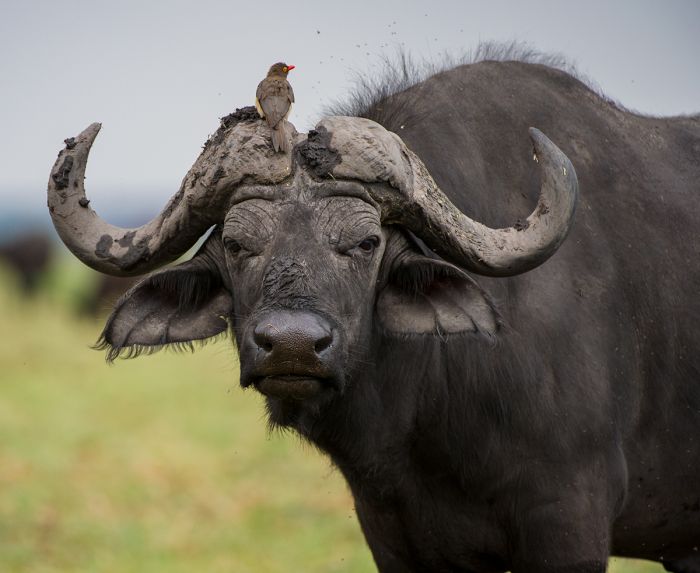
Buffalo and red-billed oxpecker (Copyright © James Weis).
Okavango Wildlife and Safaris
The Okavango is a paradise for wildlife, as can be expected with such a diverse and water-rich ecosystem. All of Africa's Big Five (lion, leopard, elephant, buffalo, and rhino) are here, as well as cheetah, African wild dog (an endangered species and safari fan favorite), spotted hyena, and more.
Plains game includes giraffe, zebra, impala, tsessebe (the southern African equivalent to the topi antelope of East Africa), greater kudu, and water-adapted species such as red lechwe and sitatunga. Bird life is extremely diverse and the summer months are especially rewarding, with many migrants arriving from the north.
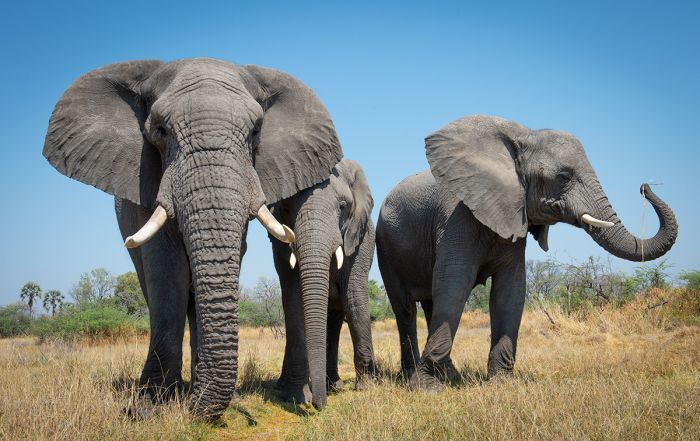
Elephants photographed during the October dry season (Copyright © James Weis).
Safaris in the Okavango include game drives in open 4WD vehicles, allowing visitors to get up close to wild animals. Outside of the Moremi Game Reserve, safari vehicles can traverse off-road to follow animals like leopards and lions as they go about their lives.
Safari camps situated near permanent water also offer safaris on the water, either in motorized boat or on mekoro (a traditional canoe which is propelled by your guide using a long pole). Some camps may also offer walking safaris.
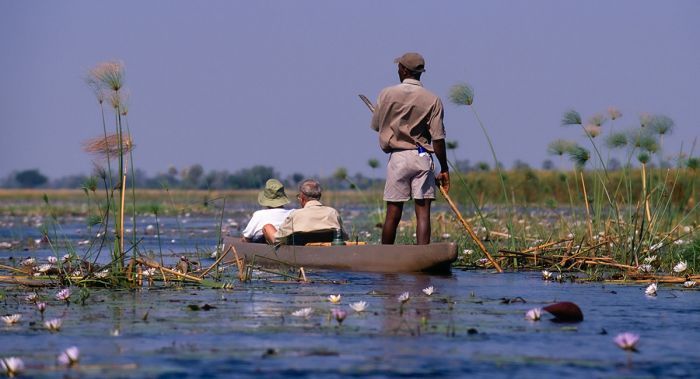
Mokoro safari in the Okavango Delta (Copyright © James Weis).
Rhinos in the Okavango
Like most of Africa, rhinos were on the brink of extinction in Botswana by the 1980s. A 1992 survey revealed that black rhinos were completely extinct in the wild in Botswana, while only 19 white rhinos were all that remained. This prompted the Botswana government to adopt a zero-tolerance policy with regards to poaching and all remaining white rhinos in the wild were captured and brought to various rhino sanctuaries to protect these last survivors.
Beginning in 2000, the Botswana government, in collaboration with Wilderness Safaris and funded by NGO's and private donors, initiated a rhino reintroduction project. The project has been successful and is ongoing, and today both species of rhino once again roam the Okavango and have even dispersed to areas beyond the Delta.
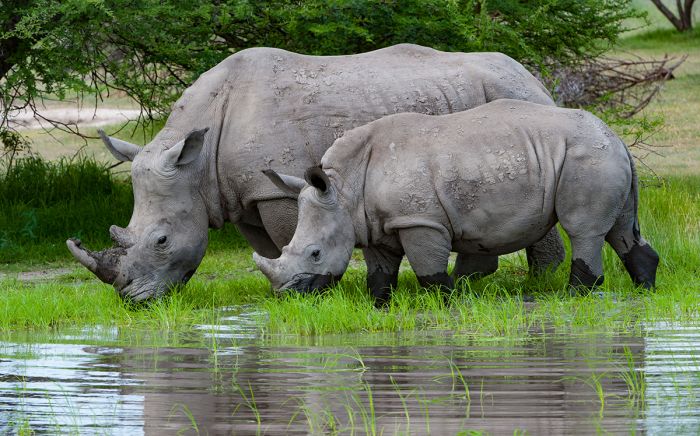
A white rhino and her calf in Moremi (Copyright © James Weis).
Maun
Maun is located at the southern boundary of the Okavango Delta and serves as the gateway for safaris to the region. Although a small town (population 50 000), its location means that daily flights from Johannesburg and other cities bring tourists on their way to safari camps throughout the Okavango, Selinda and Linyanti.
Few tourists spend more than a few hours in Maun, but its airport is a one of the busiest in Africa in terms of number of flights, with numerous charter companies flying tourists into and out of private airstrips throughout the region.
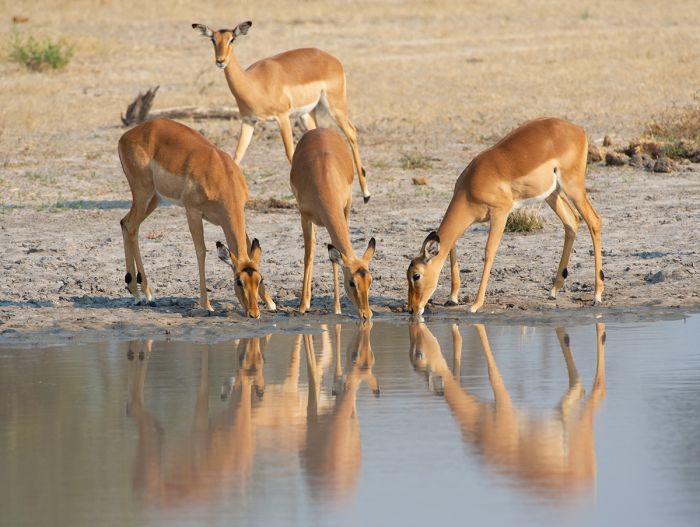
Impalas drinking; photographed in July (Copyright © James Weis).
Read More...
Geography, History, Maun, Moremi Game Reserve, Okavango Dynamics, Private Concessions, Rhinos, Wildlife & Safaris
Great Good Fair Poor
- Jan
- Feb
- Mar
- Apr
- May
- Jun
- Jul
- Aug
- Sep
- Oct
- Nov
- Dec
summer / green season
The Okavango gets most of its rain from December thru February.
November and December are wonderful months to be in the Delta, with only occasional rainstorms. January and February experience heavy afternoon downpours on most days, but all-day rain is uncommon. By mid-March, the rains are abating, but storms are still possible and the grass and vegetation has grown thick. Mornings become cooler by the end of March.
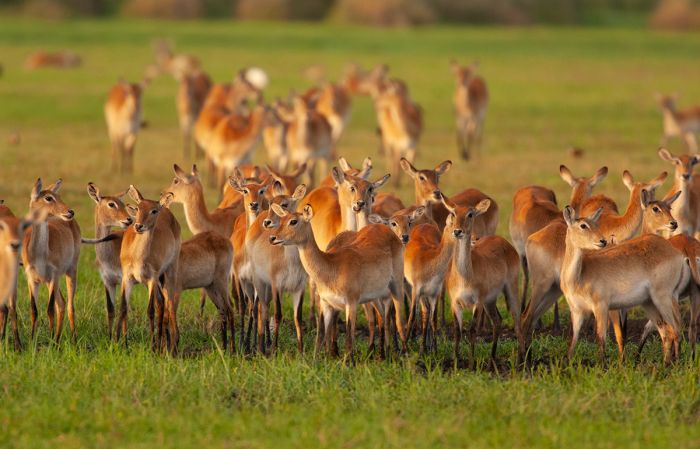
Red lechwe antelopes in the Green Season (Copyright © James Weis).
Although this is the summer in Botswana, the rains tend to keep temperatures from becoming overly hot, although humidity and insect life are at their peak. Days are mostly overcast or partially cloudy, with dramatic skies and a verdant color to the landscape. Afternoon temps average highs of 88°F (31°C), while mornings are very comfortable at around 65°F (19°C).
Baby animals are in abundance, especially herbivores like impalas and warthog piglets. Migratory birds are also in the Delta for breeding and the lagoons and pans full of water and life. Unlike the winter months, when middays are hot and animals typically seek shade from around 10am til mid-afternoon, the overcast skies in the summer often mean that animals are active throughout the day, offering many more hours of game viewing.
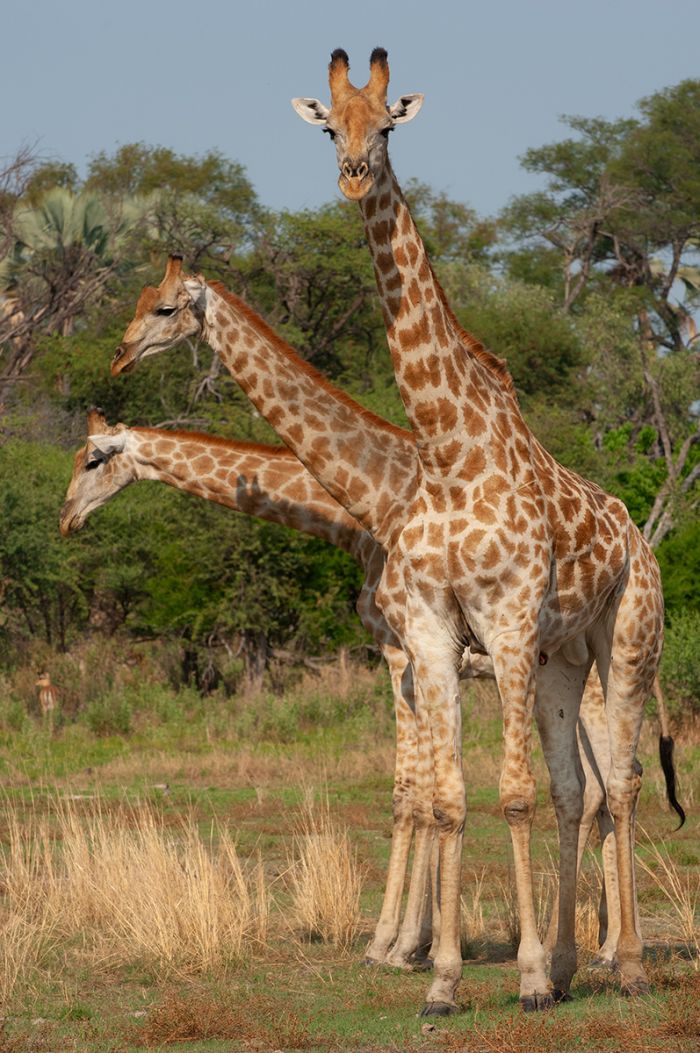
Giraffes photographed in January (Copyright © James Weis).
autumn
March, April and May are fall months and the beginning of the dry season in the Okavango, with rains very uncommon from around mid-March. The landscape is still lush and green, with sunny days and comfortable temps; afternoons average 84°F (29°C). Mornings are comfortable, but a fleece and base layer may be needed for the first hours on game drive.
Migrant birds fly north and water in the lagoons and rain pans is drying up. Permanent waterways in the Delta are however rising, as the 'flood' water from the Angolan highlands is now reaching the Delta.
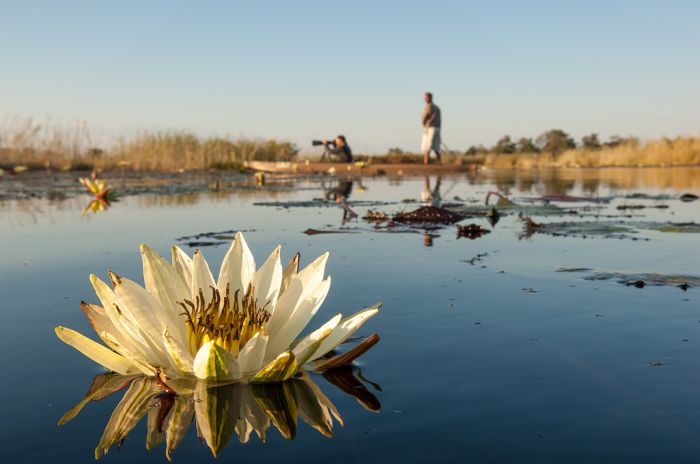
Water lily and mokoro safari in the Okavango (Copyright © James Weis).
WINTER / DRY SEASON
June through August is winter and the vegetation is drying and going dormant. The Okavango flood water is peaking but the surrounding landscape is mostly brown and yellow. Dust and sand particles in the air is on the rise. Game viewing is superb, with elephant and buffalo herds congregating along permanent water.
Mornings can be chilly to very cold at around 45°F (7°C). Warm clothes, including winter hat and gloves are needed for the open-air game drives. Dress in layers, as the temps do rise quickly during the day, with middays reaching 79°F (26°C).
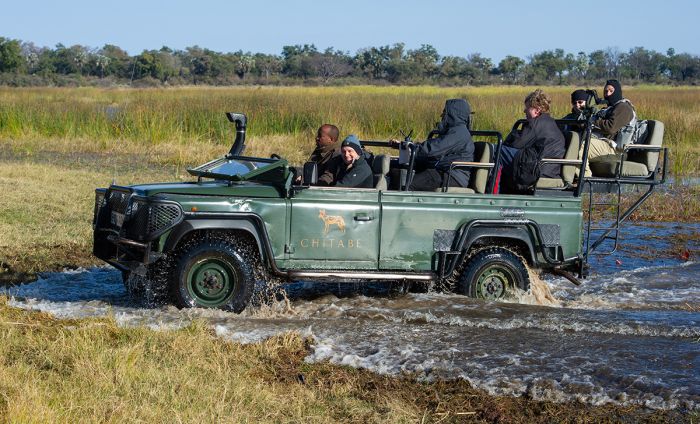
Bundled up on morning game drive in July; Okavango Delta (Copyright © James Weis).
Spring / High Season
September and October are the driest months as the landscape and animals eagerly await the coming rains. Game viewing is phenomenal, with all lagoons and rain pans completely dry and animals congregating around permanent waterways. The flood levels are down and the grass and vegetation mostly dried.
Days are warm, sunny and often cloudless and by mid-morning, most animals are seeking shelter in the shade and awaiting the evening temps to drop. October can be brutally hot and dusty and even smoky as sporadic grass fires can occur. Safari camps are mostly full to capacity, with guests adhering to guide books saying this is the only tome to visit (not true of course!) Temps in October can easily reach 95°F (35°C) or even hotter.
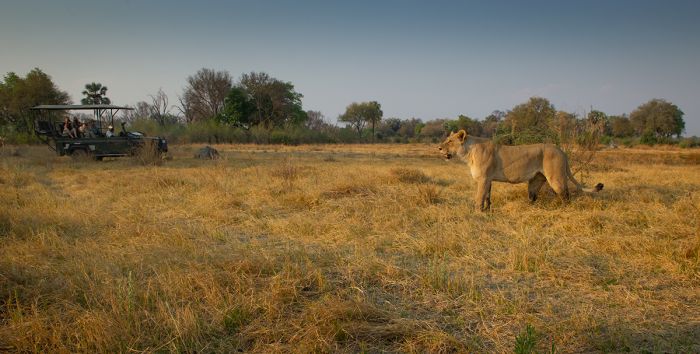
Lioness photographed end of September (Copyright © James Weis).
Showing 1–20 of 23 results
Abu is a luxurious getaway in the remote western Okavango, offering both land and water activities and diverse wildlife. The camp is renowned for its elephant conservation project and guests may interact with the Abu herd.…
Chitabe Camp is situated in one of the best game-viewing areas of the Okavango Delta. The camp is a favorite amongst safari enthusiasts for its high densities of predators and plains game.…
Chitabe Lediba Camp is a small, private camp that is ideal for groups or families traveling together. The camp is a favorite amongst safari enthusiasts for its high densities of predators and plains game.…
Small and remote camp modeled after the luxury mobile camps used by Africa's early explorers, but with modern-day conveniences and luxuries. Located in a wilderness area with both seasonal floodplains and permanent water. Game drives, boating, mokoros, walking, fishing.…
One of Botswana's most exclusive camps with only two properties in a huge, private concession. Excellent service, luxurious suites, fine dining. A prime wildlife destination with activities on land and water.…
Jacana Camp offers one of the best water-based experiences in the Okavango Delta. The area is beautiful year-round and offers diverse wildlife. The maintains a 'classic' feel that is missing from the luxury camps.…
Jao Camp is located in beautiful water-based portion of the Okavango Delta and offers both land and water activities. The camp itself is one of the most luxurious in Botswana.…
Located on a beautiful, permanent waterway in the northern Okavango with access to the Moremi Reserve. Excellent wildlife, especially during the dry season. Day and night game drives, bush walks, mokoroing, scenic helicopter flights, and cultural visits.…
A remote camp in the western Okavango, offering a mix of activities on both land and water. Wildlife is diverse and the camp is a mix of classic and luxury.…
Little Mombo is an intimate 4-suited camp which adjoins the larger Mombo Camp in the Okavango Delta. Together, these camps are known as the "Place of Plenty" for the abundance of wildlife found here.…
Little Tubu Camp is a small (only 3 tents) and intimate camp that is ideal for a small group or extended family. The camp offers seasonally superb game viewing with both land and water activities.…
Little Vumbura is a small, classic-style safari camp located on a small island in the far north of the Delta. The camp is reached via a short boat ride. The area is renowned for superb wildlife numbers and variety.…
Known as the Place of Plenty, Mombo Camp is located in the wildlife-rich Okavango Delta. The camp was completely rebuilt in 2018 and offers luxurious accommodation and outstanding game viewing in a true wilderness setting.…
Located in a superb game-viewing area in the southern Okavango Delta with a large, exclusive-use game-drive area. Offers both land- and water-based activities including game drives, boating, mokoroing, fishing, and walking.…
Very remote camp modeled after the luxury mobile camps used by Africa's early explorers, but with modern-day conveniences and hospitality. Located on a seasonal waterway with elephants, predators, and plains game. Game drives, walking, canoeing, fishing.…
Pelo is a small and intimate, classic-style safari camp in a remote area of the Okavango. The camp offers a true water-based experience, with boating, mekoros (traditional canoes), fishing, and walking.…
Qorokwe is an eco-chic, contemporary-style safari camp that blends into its natural setting. The camp offers excellent wildlife viewing and a diversity of activities on both land and water.…
Sandibe is situated in one of the best game-viewing areas of the Okavango Delta with a massive, exclusive-use game-drive area. Spacious temperature-controlled guests suites and spectacularly unique camp design and architecture.…
Seba is a classic-style safari camp offering a variety of activities on both land and water, including game drives, boating, mokoroing, fishing, and walking. Seba is family-oriented and offers educational activities for children.…




